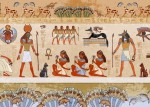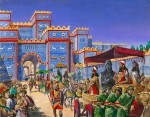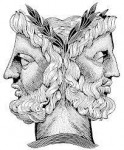Happy New Year, P-assangers! So good to see you here with our newest article in 2021! We’re sure that you guys must be very excited to read it.
But before that, we’d really like to know how you guys spent your New Year’s Eve a couple of days ago. Did you light up fireworks, eat snacks, stay up all night binging movies, or did you just sleep all the way to the morning of January 1st? Well, no matter what you did, we hope that you had a lot of fun doing it.
Well, have you ever wondered what people used to do to celebrate New Year’s, back in the old days? No, we meant back in Ancient Rome, not 1954. Really? Well, you better hold on tight because we’re about to to have a blast to the past to find out just that!
- Ancient Babylonia’s Akitu
Did you know, the earliest recorded New Year’s Celebration was from around 4.000 years ago? Yep, you read that right! Around the year 2.000 BC, the Babylonians of Ancient Mesopotamia used to celebrate a religious multi-day festival in honor of the rebirth of the natural world. This festival is called Akitu, where people paraded statues of their gods and perform rituals.
One interesting ritual involved the humiliation of the King. In this ritual, the king is brought in front of the statue of the god Marduk, stripped of his robes, swear an oath, and even get physically hurt by the High Priest until he cries! If he does, that would mean that the god Marduk was pleased by him and extended his reign. Wow, so intense!
- Ancient Egypt’s Wepet Renpet
 Hey, we get that the thing sounds funny, but it’s actually pretty cool! See, the people of Ancient Egypt lived near the Nile River. When the turn of the year comes in mid-July, and not January, it usually comes with the annual flood. They believed that this was a time of rebirth and rejuvenation, as that also meant that their farmlands stay fertile for the incoming year.
Hey, we get that the thing sounds funny, but it’s actually pretty cool! See, the people of Ancient Egypt lived near the Nile River. When the turn of the year comes in mid-July, and not January, it usually comes with the annual flood. They believed that this was a time of rebirth and rejuvenation, as that also meant that their farmlands stay fertile for the incoming year.
Thus, the people of Ancient Egypt celebrate this new beginning in a festival called “Wepet Renpet” which means “opening of the year” by feasting and partying. Sometimes it would even last a whole month! Fun!
On the other hand, this celebration meant a lot of drinking and beer. Er…. Not so cool.
- Persia’s Nowruz
Nowruz is the Persian New Year of Iranian and Zoroastrian origins, celebrated for over 3,000 years around March 21st by people worldwide. It’s mostly a secular holiday now, but still remained as a holy day for Zoroastrians and a few Muslim communities.
Nowruz is the day of the Vernal Equinox, marking the beginning of spring in the northern hemisphere. It lasts for 13 days. Some documents suggested that the Nowruz of old were a bit different from today’s Nowruz. Basically, they used to celebrate it very publicly on the first 5 days, then privately on the last 6 days, and finally throwing all their bad luck away by the 13th day by throwing wheat grass to rivers.
- Ancient Rome’s Festival to Janus
The month January was named after the Roman God Janus, who was the chief among the ancient Roman deities. As he was chief, his month was honored to be the first month of the year. The Ancient Roman people celebrated this festival by following Janus’ physical form of having two faces (one facing front and one facing backwards), and spent the day looking backwards with reflections and looking ahead for their new year. On this day, they also gave presents, food, and being kind to one another so the rest of the year would be just as good.
- Chinese New Year
Now, this wouldn’t be complete if we didn’t put Chinese New Year in the list, now, would it? Of course, as this day is one of the most famous New Year’s Celebrations in the world, although it doesn’t fall on the same day as the one on the Gregorian calender.
Legend has it, there used to be a monster named Year (or “Nian”) that only came out during New Year’s to eat people and animals alike. Because of this, everyone kept inside and ran away before the New Year to keep themselves from being eaten.
One day, an old man came to Peach Blossom village, just as the people were about to prepare themselves from the Year monster. An old lady offered to give him food and shelter, but reluctantly, as she didn’t know who he was. He replied with a promise that the village would never be bothered with Year again if she let him stay, to which she agreed.
He then decorated the village with red lanterns, candles, and lit firecrackers when Year came. Year was then so scared that it ran away. Thus, this tradition has been upheld every year to keep the monster Year away .
How about that, P-assangers? Wasn’t that interesting? It turns out, New Year’s have been celebrated for a very long time. If you pay attention, some of them include food and firecrackers, which we still do today! We hope that this article has been interesting and insightful for you, P-assangers. You can check out our other articles, too! See you next time with our newer and more interesting informations! Thank you for reading.




